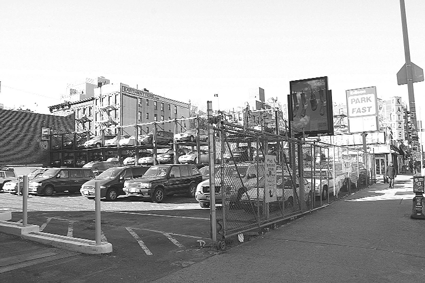By Alex Schmidt
A mountain of dirt and broken concrete grows at the intersection of Houston and Ludlow Sts. As ground is overturned and the earth probed, pile drivers prepare the lot at 188 Ludlow St. for a 23-story building that will tower above the Lower East Side. It’s a change that one longtime resident, Clayton Patterson, calls “the most dramatic in the whole neighborhood.”
Demolition of the hydraulic car-parking lifts that stood on the lot began roughly three weeks ago. Nowhere to be seen was the vehement resistance that the project originally encountered when it was first proposed almost five years ago. At that time, several community organizations joined together to oppose the variance sought by developer Edison Properties to build a tower of such height, saying the building was out of character with the neighborhood and that it would cast a shadow over residential buildings and a schoolyard. The developer said they needed the variance for some additional height because of the cost involved in building on the site, which has a difficult foundation. A community lawsuit was filed, but the court ruled in favor of Edison, and work is finally beginning on the lot.
Ludlow St. resident Marcia Lemmon was a member of Community Board 3 five years ago and remembers hearing Edison’s presentations. Of the building, she says, “You mean the pencil? It’s gonna be an ugly monstrosity.” Lemmon is concerned not only with the darkness that the building will bring to many of her neighbors, but also with the inevitable changes the 252-unit residential tower will wreak on the centuries-old Lower East Side. “It’s so obvious that it’s out of character with the neighborhood,” she said.
Patterson, who lives right next to the site, is concerned with the changing demographic landscape. He says that with developments like this tower, the Lower East Side is losing many of the creative people who could afford to live in the area when rents were lower. “It’s just the gutting of the whole creative force that made America and New York great,” he said with a sigh. “A bunch of apartments doesn’t add to our culture and our richness. It just means that a few people can profit and make a lot of money.”
A construction worker at the site this week said that 20 percent of the project’s apartments would be affordable, which would mean that the building likely could receive tax breaks under the city’s 421-a program. Spokespeople from Edison Properties and Hunter Roberts, the construction group in charge of the work, did not return calls for comment.
As the construction gets underway, plywood walls blocking off portions of the site from the sidewalk display permits allowing for use of the sidewalk and a trailer on the site. Residents and businesses alike will feel the effects, from encroachments onto pedestrian areas and vibrations of pile drivers to the permanent loss of parking space.
While customers who drive to the neighborhood for businesses and restaurants like Katz’s Deli next door will have to find another place to park, residents who used the lot to store their cars will also now have to find a new location. “It changes the dynamic of the whole neighborhood,” said Patterson.
While neighborhood residents put up a determined fight at the time of the original building proposal, Susan Stetzer, district manager of Community Board 3, said that at this stage, “We have no say and there’s nothing we can do.” Stetzer said all that the board and others can do is attempt to deal with the development on a practical level, educating people as much as possible about the impact of large-scale construction on their community.




































